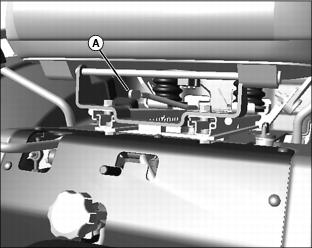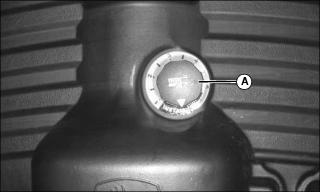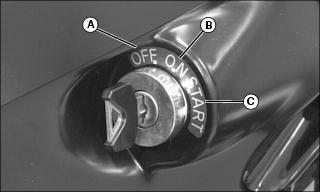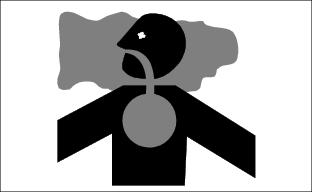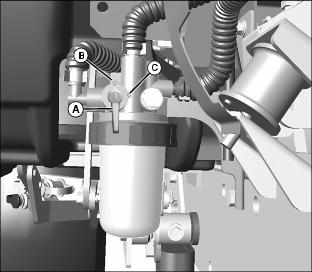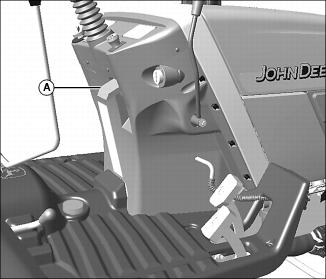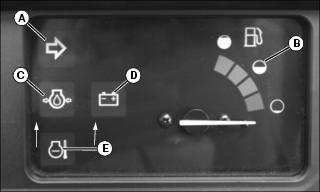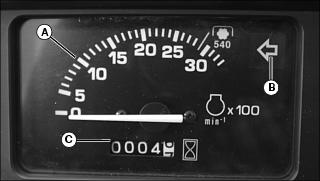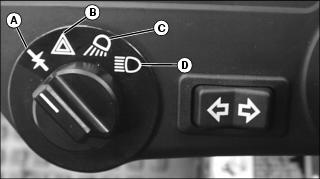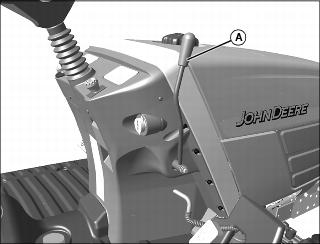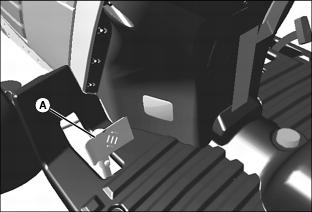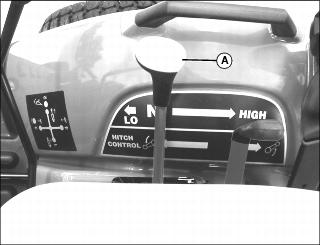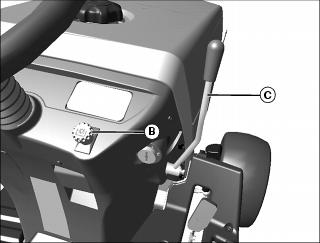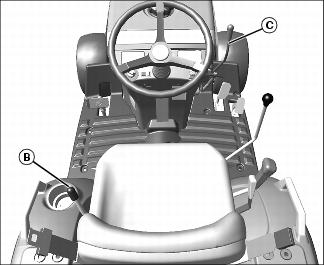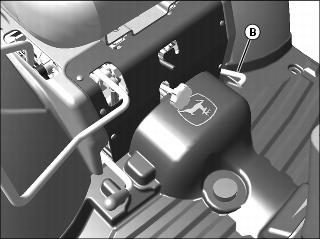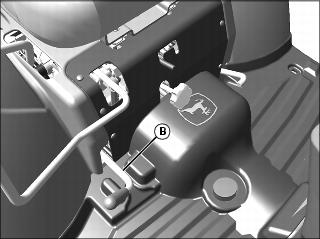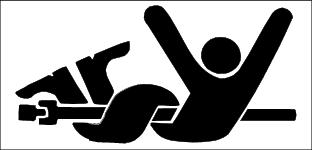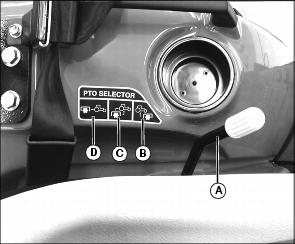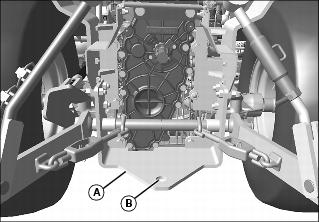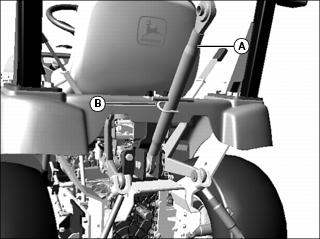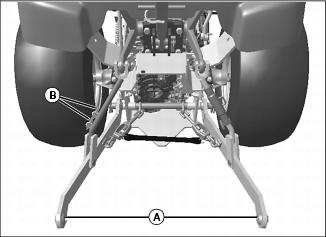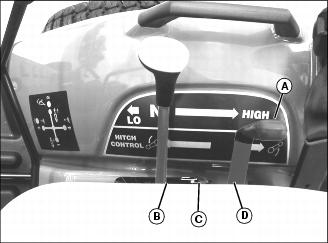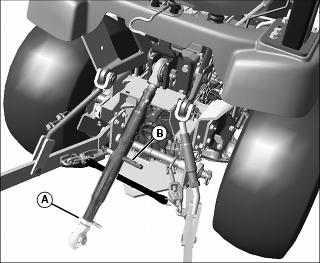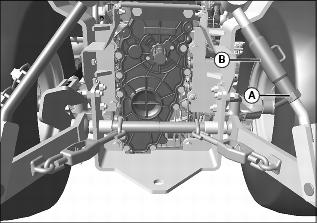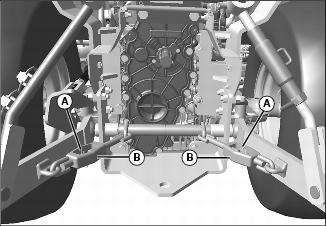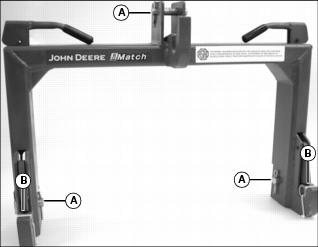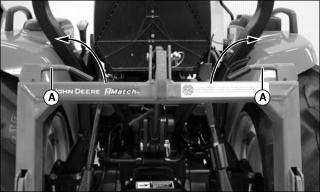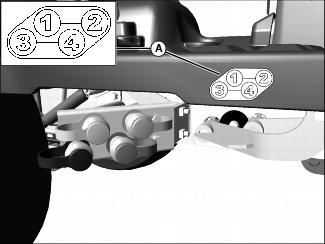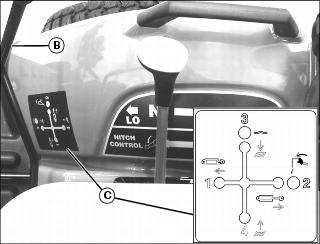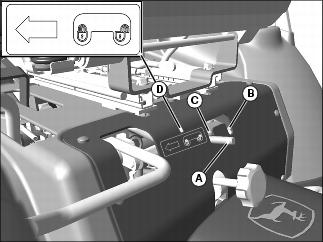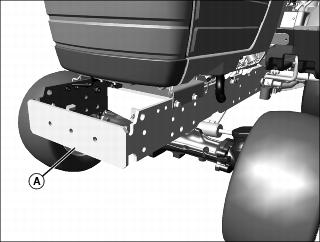
Operating
Daily Operating Checklist
o Check transmission oil level.
o Check coolant level on liquid cooled engine.
o Remove grass and debris from machine.
o Check area below machine for leaks.
Avoid Damage to Plastic and Painted Surfaces
· Do not wipe plastic parts unless rinsed first.
· Insect repellent spray may damage plastic and painted surfaces. Do not spray insect repellent near machine.
· Be careful not to spill fuel on machine. Fuel may damage surface. Wipe up spilled fuel immediately.
Operator Station
B - Light Control/Warning Flasher Light Switch
D - Power Take Off (PTO) Switch
F - Engine Speed Hand Throttle
I - Selective Control Valve (SCV) Lever
J - Transmission Range Shift Lever
N - Power Take Off (PTO) Selector Lever
Floor Panel Controls
A - Operator Seat Adjustment Lever
B - Selective Control Valve (SCV) Lock
D - Rockshaft Rate-of-Drop Control Knob
E - Mechanical Front Wheel Drive (MFWD) Control Lever
Adjusting Seat
2. Pull seat lever (A) sideways to unlock seat position.
3. Slide seat forward or rearward to desired position.
4. Release lever to lock seat in position. Make sure all controls can be easily accessed.
Adjusting Seat Belt
Fasten Seat Belt
1. Remove seat belt ends from fender mounted brackets on each side of operator seat.
2. Connect both ends of seat belt. Tighten or loosen seat belt until firmly held onto the seat.
Release Belt
1. Press red button on buckle to release seat belt ends.
2. Install seat belt ends in fender mounting brackets when seat belts are not being used.
Using Mower Height Control Knob
Use mower height control knob (A) to adjust mower cutting height, and lock mower deck lift arms in raised position. See your mower deck operator's manual for instructions.
Using Ignition Switch
A - OFF Position - In this position the engine will not run.
B - ON Position - Move key from OFF to this position and the engine oil pressure light and battery charging light will turn on. You will also hear the engine fuel shut-off solenoid engage with a click.
C - START Position - Move key from ON to this position and the starter will engage the engine flywheel to start the engine and activate the glow plugs. Release the key to the ON position.
Testing Safety Systems
The safety systems installed on your machine should be checked before each machine use. Be sure you have read the machine operator manual and are completely familiar with the operation of the machine before performing these safety system checks.
Use the following checkout procedures to check for normal operation of machine.
If there is a malfunction during one of these procedures, do not operate machine. See your authorized dealer for service.
Perform these tests in a clear open area. Keep bystanders away.
Testing the Neutral Start Switch
3. Move the transmission range shift lever to the H (high) or L (low) position.
4. Completely depress the forward or reverse hydrostatic drive pedal.
5. Turn key switch to START position.
Testing the Power-Take-Off (PTO) Switch
2. Move the transmission range shift lever to the N (neutral) position.
4. Turn key to the START position.
Testing the Seat Switch
2. Return hydrostatic travel pedals to neutral position.
5. Move the transmission range shift lever to the H (high) or L (low) position.
6. Raise up slightly from operator's seat. Do not dismount machine.
Using Fuel Shut-Off Valve
1. Open or close fuel shut-off valve lever (A) as required:
Using Park Brake
NOTE: Label on dash illustrates park brake operation.
Locking Park Brake:
1. Press down completely on brake pedal with foot.
2. Lift park brake lock (A) completely up to the locked position.
3. Remove foot from brake pedal. Pedal should now stay down in the locked position.
Unlocking Park Brake:
1. Press down completely on brake pedal with foot.
2. Push park brake lock (A) completely down to the unlocked position.
3. Remove foot from brake pedal. Pedal should now be released from the locked position.
Understanding Instrument Panel - Right Side
A -Warning Flasher/Turn Signal Indicator Light - This indicator light will turn on and flash when the light switch is turned to the warning flasher lights ON position, the headlights, taillights, and warning flasher lights ON position or the turn signal switch is moved to the right hand turn position.
B - Fuel Gauge - Shows approximately how much fuel is in the fuel tank.
C - Engine Oil Pressure Light - This light will turn on when the ignition key is in the ON position and the engine is not running. If this light turns on while the engine is running, engine oil pressure is too low. Stop engine.
D - Alternator/Battery Charging Light - This light will turn on when the ignition key is in the ON position and the engine is not running. If this light turns on while the engine is running, the alternator output is too low. Move the throttle lever to the full throttle position. Stop the engine if light remains on.
E - Engine Coolant Temperature Light - This light will turn on when the engine coolant is approaching a dangerously hot temperature. If this light turns on during operation, remove load on machine immediately. Reduce engine to idle speed and check for something blocking air flow to the radiator and check engine coolant level. If light stays on after cleaning grille, stop engine.
Understanding Instrument Panel - Left Side
A - Tachometer - Shows engine speed. Engine speed is shown in 100's. Example: If indicator is pointing at 20 (20 x 100 = 2000 RPM). Note the special marker labeled 540. With the indicator pointing at the 540 marker, this is the proper engine speed for the 540 RPM Power Take Off (PTO).
· Slow idle speed........................................1400
· Rated speed.....................................................3000 rpm
· Fast idle speed.........................................3250
B -Warning Flasher/Turn Signal Indicator Light - This indicator light will turn on and flash when the light switch is turned to the warning flasher lights ON position, the headlights, taillights, and warning flasher lights ON position or the turn signal switch is moved to the left hand turn position.
C - Hour Meter - Shows total number of accumulated running hours at rated speed. Use the hour meter as a guide when servicing various components of this machine.
Using Light Switch
NOTE: The light switch will operate only when the ignition key switch is in the ON position.
NOTE: Normal use of turn signals is possible when light switch is in either warning flasher position. Turn signals will temporarily override warning flashers when activated. When turn signals are de-activated, warning flashers will resume operation.
C - Headlights and Taillights On
D - Headlights, Taillights, Warning Flasher Lights On
Using Turn Signal Switch
NOTE: The turn signal switch will operate only when the ignition key switch is in the ON position.
NOTE: Normal use of turn signals is possible when light switch is in either warning flasher position. Turn signals will temporarily override warning flashers when activated. When turn signals are de-activated, warning flashers will resume operation.
1. Depress right side of switch (A) to operate the right turn signal light.
2. Depress left side of switch (A) to operate the left turn signal light.
3. Move switch to the centered position to turn lights off.
Using Throttle
Use the throttle to change engine speeds. Use the throttle in conjunction with the tachometer to set engine speeds.
Engine/Tachometer Speeds:
· Slow Idle Speed.......................................1400
· Special Marker 540...........................................2900 rpm
· Rated Speed.................................................... 3000 rpm
· Fast Idle Speed.........................................3250
Using Brake Pedal
1. Depress pedal (A) to operate the brake. This pedal operates a single wet-disk brake located in the left side of the transaxle. Linkage connected to the brake pedal activates the differential lock when the brake is applied, thus braking both drive axles.
Starting the Engine
1. Open the fuel shut-off valve.
3. Move the 2-speed range lever (A) to the N position.
4. Push PTO switch knob (B) down to the disengaged/off position.
NOTE: To prevent sudden lift, lower all implements to the ground before starting the machine.
5. Lower any rear mount or midmount implement to the ground by pushing the rockshaft control lever to the full forward position.
6. Lower any front mounted implement(s) to the ground using optional SCV lever.
7. Set hand throttle lever (C) to the 1/2-3/4 fast position.
8. Turn ignition key switch to the ON position.
· Engine oil pressure light will glow.
· Alternator/battery charging light will glow. Engine is now ready to start.
10. Turn key switch to START position. Release key when engine starts.
· Engine oil pressure light should go out within 5 seconds.
NOTE: Set engine speed at full throttle if indicator light does not go out after 10 seconds.
· Alternator/battery charging light should go out within 10 seconds.
· If indicator lights stay on longer than the given time interval, stop engine and check for cause.
IMPORTANT: Avoid damage! In cold weather, idle engine several minutes to allow engine oil and transmission oil to warm. |
NOTE: Allowing engine to idle for long periods of time will waste fuel and cause carbon build-up.
It is normal for the engine to be louder and for blue-white exhaust smoke to be present during engine warm-up. The amount of exhaust smoke depends on air temperature.
12. Set hand throttle lever to the 1/2 fast position for 1 minute without load.
Cold Weather Starting Aids
· Install optional engine coolant heater if you operate machine in temperatures below -18° C (0° F).
Warming and Idling the Engine
IMPORTANT: Avoid damage! In cold weather, idle engine several minutes to allow engine oil and transmission oil to warm. |
NOTE: Allowing engine to idle for long periods of time will waste fuel and cause carbon build-up.
It is normal for the engine to be louder and for blue-white exhaust smoke to be present during engine warm-up. The amount of exhaust smoke depends on air temperature.
Warming Engine:
· Set hand throttle lever to the 1/2 fast position for 5 minutes without load.
Idling Engine:
· Adjust hand throttle lever rearward to set engine speed at 1400
Starting a Stalled Engine
IMPORTANT: Avoid damage! If engine stalls while operating under load, start engine immediately to prevent abnormal heat build-up in engine. |
1. Move the 2-speed range lever to the N position.
2. Push PTO switch knob down to the disengaged/off position.
3. Start engine. Continue with normal operation, or set engine speed at slow idle speed for 1 or 2 minutes before stopping.
Stopping Machine
Normal Stopping
1. Remove foot from forward or reverse pedal.
2. Push PTO switch knob down to the disengaged/off position.
3. Push rockshaft control lever forward to lower any implement to the ground.
4. If machine is equipped with optional SCV, lower any implements to the ground using the SCV lever.
7. Adjust hand throttle rearward to set engine speed at slow idle speed. Allow engine to idle for 2 minutes.
8. Turn key switch to OFF position.
10. Wait for the engine and all moving parts to stop before leaving the operator's station.
Emergency Stopping
1. Remove foot from forward or reverse pedal.
3. Turn key switch to OFF position. Do not release brake pedal until all moving parts have stopped.
Operating the Hydrostatic Transmission
NOTE: Label on dash illustrates hydrostratic transmission operation.
IMPORTANT: Avoid damage! To prevent transmission damage, stop machine motion before moving the range shift lever. |
2. Choose speed range with range shift lever (B) to match work application.
· L - Low speed operations such as tilling hard soil, mowing long grass or heavy hauling. Machine speed is decreased, but machine power is increased.
· H - High speed operations such as light tilling and hauling, mowing short grass and transport. Machine speed is increased, but machine power is decreased.
6. Move throttle lever (C) forward until engine operates at a desirable speed.
NOTE: When the travel pedal is released, the transmission will automatically return to neutral.
7. Slowly depress FWD pedal downward to travel forward. Slowly depress REV pedal downward to travel in reverse.
· The farther either pedal is depressed, the faster the machine will travel.
8. Stop machine to change speed range.
Using Differential Lock
NOTE: Label on dash illustrates differential lock operation.
To prevent tipping, do not engage differential lock with following conditions: |
The differential lock is used to provide better traction when rear wheels start to slip. Engaging differential lock will lock right and left side rear axles together and cause both rear wheels to turn at equal speeds for maximum traction.
NOTE: Turning radius is increased when differential lock is engaged. To assist turning, release differential lock.
Engaging Differential Lock
1. Stop or slow machine movement.
NOTE: Differential lock will remain engaged as long as rear wheel slippage occurs. If tires slip and regain traction repeatedly, hold down pedal with foot so differential lock remains engaged.
2. Push down on differential lock pedal (B) to engage differential lock.
Disengaging Differential Lock
1. Remove foot from differential lock pedal.
NOTE: Rear wheel slippage will keep differential lock engaged. Lock will automatically disengage when traction equalizes.
2. If lock does not disengage when removing foot from pedal, depress brake pedal to equalize traction, then release.
Using Mechanical Front Wheel Drive (MFWD)
NOTE: Label on dash illustrates MFWD operation.
Mechanical front wheel drive (MFWD) enables the powertrain to drive all four wheels for improved traction on difficult ground conditions and provides 4-wheel braking. MFWD can be engaged and disengaged on-the-go with light loads and on low-tractive surfaces.
NOTE: It may be necessary to reduce engine load to disengage front wheel drive.
Push down on MFWD lever (B) to engage front wheel drive system. Pull up on lever to disengage the system.
Tips for operating MFWD:
· Maintain recommended front and rear tire pressures to ensure proper tire performance in all field conditions.
· Engage MFWD to provide four-wheel braking.
· Disengage MFWD when driving machine to or from work site to increase front tire life.
· MFWD may be engaged and disengaged on-the-go with light loads and on low-tractive surfaces.
Using the Power-Take-Off (PTO) Safely
Using the Rear and Mid Power-Take-Off (PTO)
IMPORTANT: Avoid damage! Use rear mounted equipment rated for 540 rpm. Do not operate mid or rear PTO over 540 RPM mark on tachometer. |
NOTE: PTO operation for this machine is not intended to be used when the operator is off the seat. The safety interlock system will stop the engine and all implements if the PTO is operating and the operator leaves the seat.
Engaging the PTO
3. Move the 2-speed range lever to the N position.
NOTE: The starter will not crank if the PTO switch knob is in any engaged/on position.
If the operator leaves the seat with the engine running and the PTO engaged, the safety interlock system will stop the engine and all implements.
5. Set engine speed to 1500 rpm or less.
6. Move the PTO control lever (A) to a desirable operating position.
· Position (B) - Mid PTO only.
· Position (C) - Mid and Rear PTO
· Position (D) - Rear PTO only.
7. Pull PTO switch knob up to the engaged/on position.
8. Adjust the hand throttle lever forward to the desired speed for the implement used.
· Mid PTO speed will be 2100 rpm at the 540 PTO marker on the tachometer.
NOTE: The tachometer indicates a standard 540 PTO at an engine speed of 2900 rpm.
Disengaging the PTO
1. Adjust engine rpm to low idle.
2. Push PTO switch knob down to the disengaged/off position.
Using Rear Hitch
The rear hitch plate (A) provides a single fixed mounting position (B) for towing.
Maximum Hitch Loads
Certain heavy equipment such as a loaded single-axle trailer can place excessive strain on the hitch. Strain is greatly increased by speed and rough ground. Do not exceed 255 kg (562 lb) maximum static vertical load on the rear hitch.
Using 3-Point Hitch
· Place center link (A) in storage hook (B) when hitch is not in use.
Using the Draft Links
1. Slowly back machine into position to align draft links with implement lift brackets.
2. Park machine safely. (See Parking Safely in the SAFETY section.)
3. Connect draft links (A) to the implement.
4. Secure implement with lynch pins (B), shown in stored position, to prevent accidental separation.
Using the Rockshaft Control Lever
Use rockshaft control lever (A) to raise and lower equipment attached to the 3-point hitch.
1. Move the rockshaft control lever to a desirable operating position.
· Push lever forward to position (B) to lower implement. Move lever to neutral position (C) after lowering implement.
· Pull lever rearward to position (D) to raise implement. Lever will automatically return to the neutral position (C) when implement has fully raised.
Using Rate of Drop/Lock Valve
The rate of drop/lock valve controls the rate of rockshaft drop when the rockshaft control lever is operated. This provides direct rate of drop control for 3-point hitch mounted implements. The valve can also be use to hydraulically lock the rockshaft (three-point hitch) in a desired position.
Increase Rate of Drop: Rotate drop/lock rate valve knob (A) counter-clockwise as indicated by the FAST and OPEN arrows.
Decrease Rate of Drop: Rotate drop/lock rate valve knob (A) clockwise as indicated by the SLOW and CLOSE arrows.
Leveling Implement Front-to-Rear
1. Park machine safely. (See Parking Safely in the Safety section.)
NOTE: When the 3-point hitch is not being used, return center link to storage hook.
2. Lower implement to ground to relieve pressure on center link.
4. Rotate handle (B) to lengthen or shorten the center link as needed.
Leveling Implement Side-to-Side
1. Lower any rear mount implement to the ground.
2. Park machine safely. (See Parking Safely in the Safety section.)
4. Rotate lift link body (B) to raise or lower draft link until 3-point hitch mounted implement is level from side-to-side.
Adjusting Implement Side-to-Side Sway
NOTE: Check implement operator's manual procedure for adjusting sway links. When sway links have been properly adjusted, side sway of implement is controlled by position of links.
1. Lower any rear mount implement to the ground.
2. Park machine safely. (See Parking Safely in the SAFETY section.)
3. Remove spring locking pin (A).
4. Rotate turnbuckle (B) to adjust length.
5. Install spring locking pin.
Using Optional iMatch Quick-Attach Hitch System
The optional quick-attach hitch fits all Category I implements designed to the ASAE Cat I standard for quick-attach hitches.
Installing Hitch
1. Remove three drilled pins (A) and two bushings (B) from quick-attach hitch.
2. Use machine rockshaft control lever to fully lower 3-point hitch draft links.
3. Park machine safely. (See Parking Safely in the SAFETY section.)
4. Position quick-attach hitch near draft links and adjust 3-point hitch sway links to align draft links with quick-attach hitch.
5. Install quick-attach hitch on draft links using drilled pins.
6. Install 3-point hitch center link on quick-attach hitch using center link quick-lock pin and drilled pin.
Connecting Implement
1. Install two bushings included with quick-attach hitch on drilled pins in implement draft link lift brackets.
2. Move levers (A) on quick-attach hitch to unlocked position.
3. Back machine into position and align quick-attach hitch with implement lift brackets.
4. Use rockshaft control lever to position quick-attach hitch under lift brackets and lift implement from ground.
5. Fully raise implement. Move levers (A) on quick-attach hitch to locked position.
Using Optional Hydraulic Selective Control Valve (SCV)
This machine series can be equipped with an optional hydraulic Selective Control Valve (SCV) and hydraulic outlets to operate hydraulically-driven implements.
The machine-mounted hydraulic outlets are female quick couplers numbered and color coded easy hookup. Label (A) identifies the couplers: 1 (yellow), 2 (silver), 3 (black), and 4 (green).
Implement hydraulic hoses are also color coded. Match the color coded hose ends to the color coded hydraulic couplers on the machine when making connections.
When the implement hydraulic hoses are connected to couplers 1 (yellow) and 2 (silver), move the dual SCV lever (B) left to divert fluid to the yellow connector line and return through the silver connector line. Move the lever right to divert fluid to the silver connector line and return through the yellow connector line.
When the implement hydraulic hoses are connected to couplers 3 (black) and 4 (green), move the dual SCV lever (B) rearward to divert fluid to the green connector line and return through the black connector line. Move the lever forward to divert fluid to the black connector line and return through the green connector line. Move the lever to the full forward or "float" position to remove pressure in both connector lines and allow fluid to flow back and forth between the lines. The lever may be locked in the "float" position.
Refer to information label (C) for assistance. See your implement Operator's Manual for implement functions which correspond to lever positions.
IMPORTANT: Avoid damage! To prevent contamination of female quick couplers, color-coded hose ends should be installed in the couplers when not being used. |
Using Selective Control Valve (SCV) Lock Lever
Picture Note: SCV lock lever shown in the locked position.
· Move lock lever (A) to position (B) to allow SCV lever movement in all directions. Operation of the SCV is unlocked.
· Move lock lever (A) to position (C) to prohibit SCV lever movement in all directions. Operation of the SCV is locked.
· Refer to information label (D) for assistance.
Connecting Implement Hydraulic Hoses
1. Park machine safely. (See Parking Safely in the SAFETY section.)
2. Relieve all hydraulic pressure by moving SCV lever rearward-to-forward and side-to-side several times.
3. Refer to implement operator's manual for instructions on connecting hydraulic hoses to couplers.
Ballasting Machine Safely
Determine amount of ballast required for each operation. Ballast used for one operation may be wrong for another. Ballast for stability, steering control and traction.
Use no more ballast than required, and remove ballast when it is no longer needed.
Ballast should be limited by machine and tire capacities. Each tire has a maximum inflation pressure and a maximum load capacity which must not be exceeded.
Additional front ballast may be required for road travel with rear mounted implements.
See your implement operator's manual for ballasting requirements.
Determining Maximum Rear Ballast
Locate the maximum load information embossed into the tire side wall.
Use the following charts to determine the maximum inflation pressures to use with tires at maximum loads.
Using Rear Wheel Weights
Up to three wheel weights can be installed on each rear wheel. Rear wheel weights are available in 23kg (50 lb) and 33kg (72 lb) sizes.
See your John Deere dealer for rear weights and kits to best fit your needs.
Refer to weight kit installation instructions for further information.
Using Rear Ballast Box
The rear ballast box is used for carrying ballast on the 3-point hitch. Approximate weight of different materials is given in the implement operator's manual.
Using Liquid Weight in Tires
NOTE: Use of alcohol as ballast is not recommended. Calcium chloride solution is heavier and more economical.
A solution of water and calcium chloride provides safe economical ballast, and will prevent freezing. If used properly, it will not damage tires, tubes, or rims.
A mixture of 0.4 kg of calcium chloride per liter of water (3.5 lb/gal), will not freeze solid above -45° C (-50° F).
Fill tubeless tires at least to valve stem level (minimum 75% full). Less solution would expose part of rim, possibly causing corrosion.
Tube-type tires may be filled to any level below 90%.
Determining Maximum Front Ballast
Add weight to front end if needed for stability. Heavy pulling and heavy rear mounted implements tend to lift front wheels. Add enough ballast to maintain steering control and prevent tip over. Remove weight when it is no longer needed.
Use the following chart to determine the maximum inflation pressures to use with tires at maximums loads.
Using Front Weights
Front weight bracket (A) is an integral part of the machine frame.
The bracket will hold up to five 19 kg (42 lb) Quick-Tatch® weights.
Quick-Tatch weights and attaching / retaining hardware are available at your John Deere dealer.
See your implement operator's manual for installation and required number of weights to use.
Optional Front Weight Bracket Extension
There is an optional front weight bracket extension kit available at your John Deere dealer. This optional front weight bracket extension kit expands the capacity to nine 19 kg (42 lb) Quick-Tatch weights.
Transporting Machine
Driving Machine Safely on Roads
Observe the following precautions when operating the machine on a road:
· Make sure brake linkage is properly adjusted.
· Make sure Slow Moving Vehicle (SMV) emblem and warning lights are clean and visible. If towed or rear-mounted equipment obstructs these safety devices, install SMV emblem and warning lights on equipment.
· Turn on flashing warning lights and headlights on, except if prohibited by law.
· Machines with cabs must have at least one rear view mirror to permit the operator to see the road behind the machine.
· Secure towed loads with locked hitch pins and safety chains.
· Drive slowly enough to maintain safe control at all times. Slow down for hillsides, rough ground, and sharp turns, especially when transporting heavy, rear-mounted implements.
· If equipped, disengage the MFWD to reduce tire wear.
· Never coast machine downhill.
Pushing or Towing Machine
1. Push PTO switch knob to the disengaged/off position.
2. Disengage differential lock.
4. Place the range shift lever in the N (neutral) position.
6. Be prepared to use the brake pedal to slow or stop machine.
Transporting Machine on a Trailer
NOTE: Use a heavy-duty trailer to transport machine.
1. Drive machine forward onto trailer.
2. Lower any implements to trailer deck.
6. Close the fuel shut-off valve.
7. Fasten machine to trailer with heavy-duty straps, chains, or cables. Both front and rear straps must be directed down and outward from machine. Trailer must have signs and lights as required by law.
Towing Loads
1. Hitch the towed load only to the rear hitch plate.
2. Connect safety chains to the lower draft arm crossbar and to the towed load. Provide only enough slack to permit turning.
Using Safety Chain
1. Secure the safety chains around the crossbar (A) that supports the lower draft arms (B).


